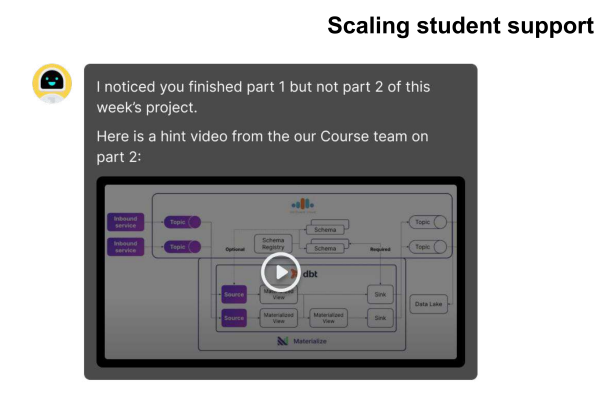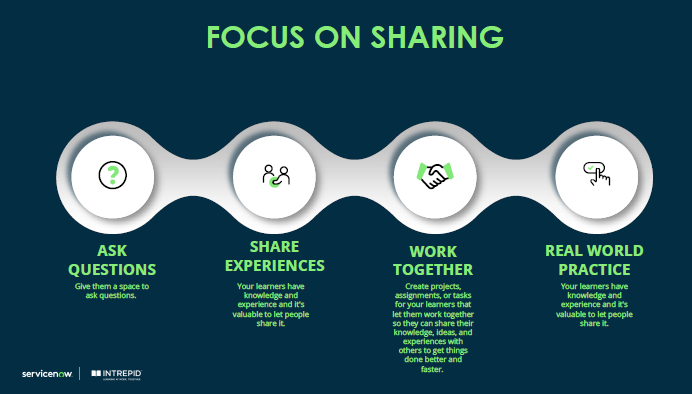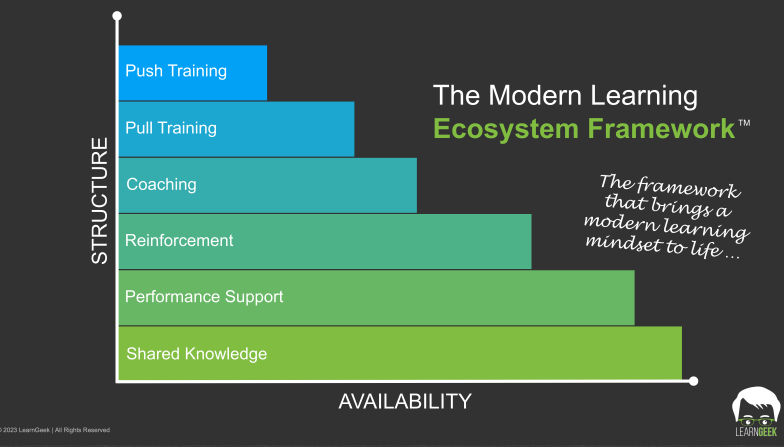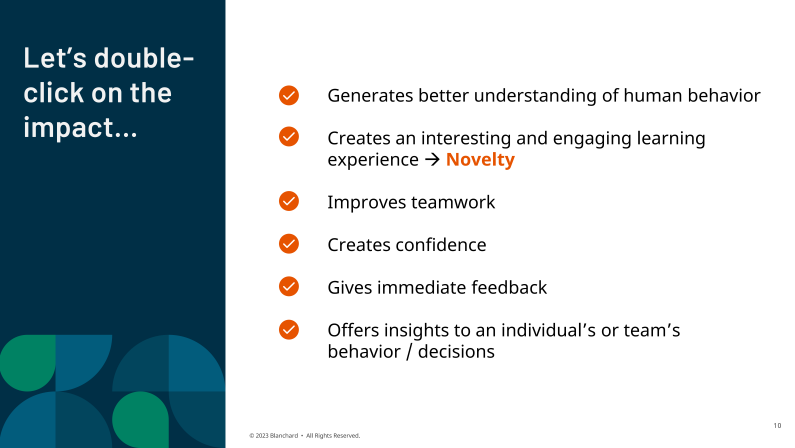In today's fast-paced world, learning and development (L&D) professionals are constantly seeking innovative approaches to meet the evolving needs of organizations and learners. As we strive to optimize L&D methodologies and effectiveness, it's crucial to stay updated on the latest trends shaping the industry. In this blog post, we'll explore the Top 12 Learning and Development Trends that our team observed at the 2023 Association for Talent Development’s (ATD’s) annual conference in San Diego.
Let's dive in!
L&D Trend #1: AI in L&D - The Changing Landscape of Learning and Work
Artificial intelligence (AI) is revolutionizing various industries, and AI in L&D is no exception. Research from OpenAI indicates that up to 80% of the U.S. workforce will be affected by generative AI. After attempting to enter ballroom-sized rooms that had standing or floor-sitting room only to hear about the monumental impact of ChatGPT, it was clear that this trending topic continued to be at the forefront of people’s minds at ATD23.
Audience conversations and questions for the speakers demonstrated strong interest in sorting through the hype and really trying to hone in on how to adapt training and development strategies to leverage AI technologies effectively. AI can be used to personalize learning experiences, develop course outlines and training modules, supercharge content, provide real-time feedback, and even predict future learning needs. In the session “What Will Generative AI Do for You This Year?”, the speakers discussed use cases for using AI to scale student support and feedback and create effective upskilling processes through virtual role playing and guided self-assessments.
 Karie Willyerd, LTG; Julia Stiglitz and Sourabh Bajaj, CoRise – Scaling Student Support
Karie Willyerd, LTG; Julia Stiglitz and Sourabh Bajaj, CoRise – Scaling Student Support
While some reactions are mixed, skeptical, or unsure, the significant focus on AI at the ATD conference reflects its importance as a transformative tool that is already reshaping the future of L&D. However, it’s important to remember that AI should be used to augment human capabilities, not replace them.
 Karie Willyerd, LTG; Julia Stiglitz and Sourabh Bajaj, CoRise
Karie Willyerd, LTG; Julia Stiglitz and Sourabh Bajaj, CoRise
L&D Trend #2: Leadership, Psychological Well-being, and… Puppies
Creating a high-performance culture requires leaders who prioritize psychological well-being. By understanding the impact of leadership on employee performance, organizations can foster supportive environments that enhance overall productivity, employee engagement, and learning retention. And what better way to reinforce sessions focused on psychological well-being than by having a mind-recharging area in the expo hall complete with none other than puppy meet-and-greets!
Puppies have been shown to reduce stress and increase feelings of happiness, so don’t be afraid to think outside the box with L&D initiatives. The talk of the conference each day revolved around the cuteness overload at the puppy station and wondering when they would return, with the crowds, lines, and demand giving the trending popularity of AI and ChatGPT a run for their money.
L&D Trend #3: Creating Analytics Toolkits
An analytics toolkit refers to a set of tools and technologies used to collect, analyze, and interpret data. An L&D analytics toolkit can include components from learning management systems, learning experience platforms with built-in analytics capabilities, data visualization tools, analytics dashboards, and survey tools.
By customizing your toolkit based on what you’re trying to achieve, you can measure the impact of learning initiatives, identify knowledge gaps, personalize learning experiences, fuel performance improvement, and make more profitable data-driven decisions. With cutting-edge tools and technologies at our fingertips, leveraging data insights to ultimately enhance the ROI of learning efforts shouldn’t be overlooked.
In a session called “Delivering Results That Executive (and Others) Will Love,” speaker Jack Phillips, Chairman of the ROI Institute, Inc., discussed a fixed a process and tool kit as a Design Thinking Principle to measure results and calculate ROI. The idea was to use your tool kit to:
- Isolate the effects of the program
- Convert impact data to money
- Identify intangible benefits
- Tabulate the cost of the program
- Calculate ROI
While tools to measure learning impact are becoming increasingly sophisticated and useful, measuring the business impact of learning requires professionals to master the skills of learning program measurement – irrespective of enabling tools. Designing and executing a well-conceived learning measurement strategy is a perennial challenge, and a fundamental skill for learning professionals. Perhaps that’s why sessions and workshops on learning these skills from the experts like the ROI Institute are always packed at ATD!
L&D Trend #4: Learner-Centric Approaches
The shift toward learner-centric models continues to gain momentum. This means putting the needs and preferences of the learner at the center of the training program, rather than focusing solely on the content or delivery method. Learning-centric approaches can include personalized learning paths, interactive and engaging content, hands-on application and practice, and opportunities for feedback and collaboration between learners and experts.
By prioritizing the learner, L&D professionals can create more effective and engaging training programs that nurture creativity and imagination and better meet employee needs. The trend towards learner-centric approaches is resulting from the understanding that when learners are actively engaged and motivated in learning that is relevant and applicable to their work, they are more likely to effectively retain and apply new skills while improving performance.
In her session on making programs learner-centered, Carla Torgerson, Head of Learning Experience Strategy at TorranceLearning, recommended:
- Focusing on the learner’s WHY – why does this matter to them
- Focusing on actionable things or examples they are likely to care about
- Focusing on the value for their time – “After just 10 minutes, you’ll be able to…”
- Making it as mobile-friendly as possible – enable them to engage anytime, anywhere
- Encouragement nudges focused on their WHY
- Enabling them to engage with like-minded learners (peer groups, social features)
L&D Trend #5: Unlocking Organizational Knowledge and Innovation
To unlock the full potential of organizations, L&D professionals are exploring ways to tap into internal organizational knowledge and drive innovation through knowledge-sharing initiatives. By leveraging collaborative learning platforms and tools, for instance, companies can harness the collective intelligence of their workforce through a focus on sharing.
 Shellie Grieve, ServiceNow and Tim Chudy, Intrepid by VitalSource
Shellie Grieve, ServiceNow and Tim Chudy, Intrepid by VitalSource
In the session, “Designing Collaborative Learning Programs at Scale,” Shellie Grieve, Director of Innovation – Collaborative Learning at ServiceNow, shared the Designers Toolbox she uses in her learning initiatives. The toolbox has features taking many forms to support collaborative learning, such as discussion forums, leaderboards, group workspaces, project sharing, and more. Her collaborative learning focus resulted in many significant metric improvements, including increasing pass rates by more than 30% and increasing Net Promoter Scores (NPS) by nearly 60%.
This not only fosters a culture of continuous learning and development, but also promotes innovation and creativity. When employees are given a space to share experiences, ask questions, collaborate, and practice, organizational skill gaps shrink and immediate benefits are delivered to learners. And when 50% of employees worldwide will need reskilling by 2025 according to the World Economic Forum, it’s no wonder the topic of collaborative learning was widespread throughout the conference.
L&D Trend #6: Coaching
This single word could be seen in numerous exhibitor taglines and in almost 20 session titles. Traditional coaching strategies and fundamentals were highlighted to inspire and motivate, along with many addressing the growing innovations in AI- and video-powered coaching. For instance, you can have a salesperson record a video where they practice responding to objections from a prospective client. Through AI-powered technology such as Bongo, they can be given a score and recommendations based on things like keywords discussed, filler words used, and conciseness of delivery.
Coaching and mentoring programs provide employees with personalized support and guidance to help them reach their full potential. Regardless of how coaching is delivered, the reoccurring theme was “in the moment” coaching and incorporating the process into everyday conversations and the flow of work. Consistency is what will make things stick, while fostering confidence, skill-building, employee engagement and retention, personal development, and leadership development.
L&D Trend #7: Survival of the Fittest - The Learning Tech Ecosystem
The learning ecosystem was another key concept discussed in many sessions. A learning ecosystem is the compilation of everywhere learning takes place inside and outside of an organization, including from technologies, tools, and people.
The Modern Learning Ecosystem is a framework that provides a practical and flexible approach to adapting to changes in the workplace. JD Dillon presented a bar graph illustrating that the bulk of modern learning (the bottom four bars) is not the PowerPoint presentations, training modules, and instructor-led content that we often associate with it. It’s about making learning part of the flow of work and enabling employees to succeed through tools and right-fit support – ideas pioneered by fellow presenters Conrad Gottfredson and Bob Mosher who shared their wisdom in their session, “Workflow Learning’s ADDIE.” Dillon’s framework and Gottfredson’s and Mosher’s ideas can help improve employee performance, which leads us to learning and development trend #8.
 JD Dillon, Author, The Modern Learning Ecosystem
JD Dillon, Author, The Modern Learning Ecosystem
L&D Trend #8: Performance Improvement in a Changing Environment
Organizations face a myriad of employee challenges these days, including workplace stress, burnout, and talent shortages. To address these issues, L&D professionals are developing strategies that support performance improvement and resilience.
You want to make sure that your training is in alignment with performance needs. Talk to your employees, then modify the training. This can improve job performance in a way that helps maximize organization-wide results. Along these lines, after an employee completes a learning program, don’t refer to them as a learner anymore—they are a performer. There’s a transition.
In his session on “Retooling Your Training and Evaluation Strategy for 2023,” Jim Kirkpatrick goes a step further and discusses how an instructional designer’s business card should say “Learning and Performance Architect,” since it is no longer just designing instruction and building training. It’s also building a performance, support, and accountability path so at the end of training, you’re building something bigger than the training itself.
“Focus on performance. That’s the future.”
-Jim Kirkpatrick, Kirkpatrick Partners
L&D Trend #9: Simulation-Based Learning
Simulations provide immersive and experiential learning opportunities, enabling learners to practice and apply their skills in safe and controlled real-world scenarios. Various types of simulations can include live, hands-on or physical, online, or immersive. These tools can be used to train employees on complex systems or processes, allowing them to fail safely and gain a deeper understanding of how things work. The number of exhibitors at this year’s conference focused on simulation-based solutions was hard to miss.
 Britney Cole and Ann Rollins, Blanchard – The Impact of Simulation-Based Learning
Britney Cole and Ann Rollins, Blanchard – The Impact of Simulation-Based Learning
However, simulations can be challenging for organizations to implement either because off-the-shelf versions lack important business context, or due to the high cost of creating a bespoke sim. We were excited to spot a new simulation authoring solution (SimGate from The Regis Company) for organizations to create and deliver their own immersive, customized simulations at a fraction of the cost of traditional bespoke development.
Piggy-backing on the AI technologies learning and development trend, ChatGPT can also integrate with virtual reality (VR) and augmented reality (AR) platforms, creating immersive and interactive learning environments.
L&D Trend #10: Learning Professionals Are Back to Business!
After three long years of pandemic-impacted industry events, L&D professionals are back to business! They attended the conference in pre-pandemic numbers, and interacted with each other with vigor and excitement that was exciting and refreshing. We saw this in over-subscribed sessions, genuine and thoughtful conversations between providers and practitioners in the expo hall, and an array of social events each evening – from the ATD Networking night to hosted events like the Intrepid-Bongo Harbor Cruise.

L&D Trend #11: The Classics Still Deliver
Amidst all the disruptive technology, economic, and social changes that were unmistakable forces at ATD, the “legends of learning” delivered timeless wisdom for learning and development practitioners. Wisdom that we would all do well to study and apply! A few of the leaders who shared their wisdom and experience at ATD include Ken Blanchard on leadership, Joseph Grenny on accountability culture, Jack and Patti Phillips on learning measurement, Bob Mosher and Conrad Gottfredson on learning in the flow of work, and David Kelly on learning technologies (among many others!).
L&D Trend #12: Martinis and Whiskey and Swag, Oh My!
Exhibitor creativity, giveaways and libations were in full force from the time the expo hall opened its doors to the time they closed. As you strolled the expo hall aisles, you were sure to find something unique, goofy, useful, or tasty that caught your eye.
From martini buffets and seeing your face on a cookie to sporting a balloon ring while being lured into an exhibit floor dance party, there was no shortage of memorable trinkets and booth experiences to keep people talking.
Summary
As learning and development professionals, it's critical to stay on top of the ever-evolving L&D trends that shape the industry. What were the Top 12 Learning and Development Trends from ATD23? The Top 12 L&D Trends included:
- AI, ChatGPT and the changing landscape of work
- Leadership, psychological well-being, and puppies
- Analytics toolkits and measurable impact
- Learner-centric approaches
- Unlocking organizational knowledge and innovation
- Coaching
- Flexible and open learning tech ecosystems
- Performance improvement in a changing environment
- Simulation-based learning
- Learning professionals are back to business!
- The classics still deliver
- Martinis and whiskey and swag, oh my!
We can hear keynote Priya Parker’s words echoing in our ears as we returned home from San Diego to strategize for the second half of the year and beyond:
“Change does not happen without risk. Transformation doesn’t happen without risk… (the key is to) unlock the purpose.”
As the trends keep coming and the possibilities keep growing, continue to keep what you’re trying to achieve at the forefront of your decision-making. When the purpose is unlocked, the door is open to the full potential of learning and development.
false LOREM IPSUM TITLE




 Previous
Previous
